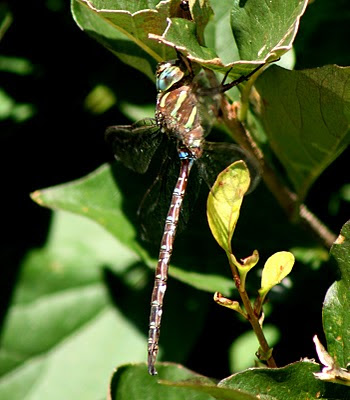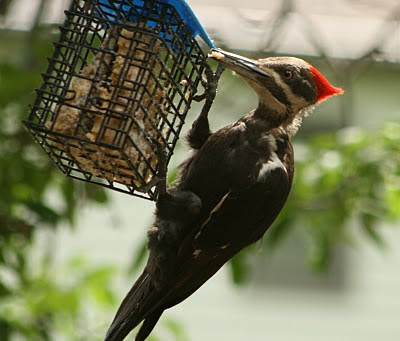22 October, 2011
02 October, 2011
Seeing Red
I'm in Georgia now, visiting my Mother for a bit. Most of the summer, the weather in Georgia was monstrously hot and somewhat dry. But now the weather is perfect with highs in the 70s and 80s and lows in the 40s and 50s. We have been taking advantage of the warm, sunny days to go out to Sutton Park, a city park here in Elberton, to walk the trails.
 |
| The trails are smoothly paved, making navigation easy. The occasional benches are perfect for stopping to observe the flora and fauna. |
 |
| This cluster of fruits is from a cluster of flowers surrounded by 4 showy white bracts that serve as the petals. You can see the bud for next springs flower right next to the fruits. |
We also saw many specimens of another favorite tree of mine - the Southern Magnolia, Magnolia grandiflora. I don't have any photos of the trees to show you, but I do have shots of their cones with bright red seeds peeking out.
Botanically speaking, these aren't really cones; they are fruits. But they are commonly called cones because of their shape. Makes sense to me!
 |
| The lovely red seeds are eaten by squirrels, turkeys, quail, opossums, other animals. |
The Southern Magnolia is native to the southeastern US, but is cultivated in many parts of the world. It grows to great heights (90ft, 27.5m), has glossy, evergreen leaves, and magnificent creamy white flowers in the summer.
Today is yet another lovely day; I'm sure we will make another trip to the park. Wonder what we will see this time?

26 September, 2011
Colorful Birds
This spring we were fortunate to have a number of Indigo Buntings pass through and make a stop at our bird feeders.
 |
| Here is an English House Sparrow at the feeder with an Indigo Bunting. The Bunting is somewhat smaller than the sparrow. |
There were at least 3 adult males.
I'm not sure how many of non-descript females were around.
 |
| I believe this is a female Indigo Bunting. |
 |
| But I am not certain. |
 |
| The females often have some blue on the wings, and I don't see any blue on this one. |
 |
| The males are unmistakable with their nearly solid blue color. The heads are often darker, almost purple. |
24 September, 2011
Big Chipping Sparrow Baby
They are quite small, but very dapper with their chestnut cap and white stripe just across the upper eye.

 |
| "Hey. Where did you go?" |
Although the chipping sparrow adult didn't look rundown from all of its efforts to feed its big baby, the cost was in the loss of its own young for this season. Other chipping sparrows were successful, though, and we saw many real families at the feeder. They will be leaving soon for their winter home not too far to the south of us.

20 September, 2011
Dragons of Autumn
The sun came for about 90 minutes on Sunday and that brought out hordes of dragonflies. I was able to get a few digitally immortalized and even managed to put names to them, although I stand to be corrected by anyone who knows better.
 |
| Meadowhawk, Sympetrum species. Not sure which one. |
17 September, 2011
Pileated Woodpecker Visits the Suet Block
The pileateds are probably the largest of the North American Woodpeckers. I say "probably" because there is a slim possibility that the larger Ivory Billed Woodpecker is, in words from Monty Python's Spamalot, "not dead yet!"
You can get an idea of how large she is in the photo below of her on suet feeder. They can reach almost 20 inches in length.
I say "she" because she lacks the red moustache and forehead seen on males.
She looks rather ungainly on this suet feeder. I have seen suet feeders made specifically for woodpeckers with a vertical board located below the suet block that serves as a tail brace.
The lack of a tail brace didn't deter this bird from feeding.
We hear them in the woods behind our house with their distinctive call and slow, deep hammering. They prefer large trees in which to excavate a cavity for nesting and there are plenty of large trees in our woods.
If you double click on the photo below you can get a glimpse of her tongue sticking out. Apparently they have long barbed tongues that they use to pull ants and termites out of tunnels.
You can get an idea of how large she is in the photo below of her on suet feeder. They can reach almost 20 inches in length.
I say "she" because she lacks the red moustache and forehead seen on males.
She looks rather ungainly on this suet feeder. I have seen suet feeders made specifically for woodpeckers with a vertical board located below the suet block that serves as a tail brace.
The lack of a tail brace didn't deter this bird from feeding.
We hear them in the woods behind our house with their distinctive call and slow, deep hammering. They prefer large trees in which to excavate a cavity for nesting and there are plenty of large trees in our woods.
If you double click on the photo below you can get a glimpse of her tongue sticking out. Apparently they have long barbed tongues that they use to pull ants and termites out of tunnels.
16 September, 2011
Monarch Migration
Night before last, a big cold front was scheduled to move through and bring us the first frost of the season. Dennis and I moved a lot of our potted plants inside and covered all the others that we left out on the patio. It was a lot of work, but worth it because I doubt we will have another frost for a few more weeks. I'm just not ready to see the outdoor growing season come to end just yet!
Yesterday, which dawned bright and clear, was pretty chilly - the low temp was a degree or so below freezing, so we were glad that we had taken care of the plants. In the afternoon I was sitting at my desk at work in my north facing office on the 12th floor and was treated to the start of the monarch butterfly migration. In less than one hour, I saw at least 20 monarch butterflies heading south past my window in downtown Rochester, Minnesota. The cold front had initiated the big migration.
 |
| Nectaring on purple coneflower. |
Subscribe to:
Comments (Atom)

































